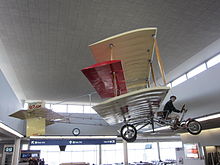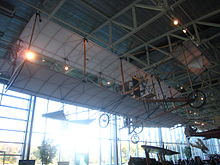- Curtiss Model D
-
Curtiss Model D A "Headed" Curtiss Model D (Curtiss photo 1916) Pusher
later "Headless" models incorporated elevators around the rudder in the tail (like most aircraft since).Role Manufacturer Curtiss Aeroplane and Motor Company Introduction 1911 Status historic Primary user Exhibition Pilots, Aeronautical experimenters
United States Navy
Aeronautical Division, U.S. Signal CorpsThe 1911 Curtiss Model D (or frequently, "the Curtiss pusher") was an early United States pusher aircraft with the engine and propeller behind the pilot's seat. It was among the very first aircraft in the world to be built in any quantity — all of which were produced during an era of trial and error development and equally important parallel technical development in internal combustion engine technologies.
It was also the type of aircraft to make the first take-off from the deck of a ship, the USS Birmingham, and the first landing, on the USS Pennsylvania several days apart.
Originally it was fitted with a foreplane for pitch control, however this was dispensed with when it was accidentally discovered to be unneccesary. The new version without the foreplane was known as the Headless Pusher. Like all Curtiss designs, the aircraft utilized ailerons to control rolling in flight instead of the Wright brother's patented wing warping technology, derived from the June Bug of 1908.
Contents
Development
The Model D was a biplane fitted with a wheeled tricycle undercarriage. The construction was primarily of spruce, with ash used in parts of the engine bearers and undercarriage beams, with doped linen stretched over it. The outrigger beams were made of bamboo[1]. Prevented by patents from using the Wright brothers' wing warping technique to provide lateral control, Curtiss used ailerons instead. In the end, this proved to be a superior solution. Almost all Model Ds were constructed with a pusher configuration, with the propeller behind the pilot. Because of this configuration, they were often referred to as a "Curtiss pusher". Early examples were built in a canard configuration, with elevators mounted on struts at the front of the aircraft in addition to a horizontal stabilizer at the rear. Later, the elevators were incorporated into the tail unit, and the canard surface arrangement dispensed with, resulting in what became called the Curtiss "headless" pushers.
In addition to amateur aviators, a Model D was purchased in April 1911 by the Aeronautical Division of the U.S. Army Signal Corps as a trainer (S.C. No. 2), and by the Navy as an airborne observation platform. A number of them were exported to foreign militaries as well, including the Russian Navy. On 14 November 1910, Eugene Ely took off from the USS Birmingham in a Model D. This was the first time an aircraft had taken off from a ship[2]. On 18 January 1911, Eugene Ely landed a Model D aboard the USS Pennsylvania. This was the first aircraft to land on a ship.
Upon his election to Congress in November 1915, Orrin Dubbs Bleakley became the first government official to fly from his home state to DC. The trip was made in a 75 hp (56 kW) Curtiss biplane from Philadelphia, piloted by Sergeant William C. Ocker, on leave from the United States Aviation Corps at the time. The trip took 3¼ hours, including an unscheduled stop in a wheatfield in Maryland.[3]
Variants
-
- Model D-4
- with one 40 hp (30 kW) Curtis four-cylinder inline engine[2]
-
- Model D-8
- Signal Corps Number 2, one 40 hp (30 kW) Curtis Vee engine, top speed of 60 mph (97 km/h) at sea level[2]
-
- Model D-8-75
- with one 75 hp (56 kW) Curtis eight-cylinder Vee engine[2]
-
- Burgess Model D
- single prototype built under licence by Burgess Company of Marblehead, Massachusetts [4]
Existing aircraft and reproductions
 "Headless" Model D replica at Minneapolis-St. Paul International Airport
"Headless" Model D replica at Minneapolis-St. Paul International Airport
A number of Curtiss Pusher original and reproduction aircraft exist, and reproductions of the design date as far back to the era when the original aircraft was in production, mostly built by private parties.
The Old Rhinebeck Aerodrome has had a flyable reproduction Model D pusher in their collection since 1976, and has been powered with a Hall-Scott V8 engine earlier in its weekend airshow appearances, and most recently has been powered with a Curtiss OX-5 V8 engine.
The College Park Aviation Museum built a replica of the Curtiss Model D once flown in 1911 at College Park Airport in Maryland.
There is a Model D with an O-300 (145hp) Cont. Engine at the Owls Head Maine Transportation Museum also.
A Model D replica is exhibited at Minneapolis-St. Paul International Airport.[5]
Operators
- United States Army
- Aeronautical Division, U.S. Signal Corps
- S.C. No.2 (1911-1914)
- Aeronautical Division, U.S. Signal Corps
- United States Navy
Specifications (Model D Type IV)
General characteristics
- Crew: one, pilot
- Capacity: 1 passenger
- Length: 29 ft 3 in (8.92 m)
- Wingspan: 38 ft 3 in (11.66 m)
- Height: 7 ft 10 in (2.39 m)
- Empty weight: 700 lb (318 kg)
- Loaded weight: 1,300 lb (590 kg)
- Powerplant: 1 × Curtiss E-4, 40 hp (30 kW)
Performance
- Maximum speed: 50 mph (43 kn, 80 km/h)
- Endurance: 2.5 hours
See also
- Related development
- AEA June Bug
- Curtiss Golden Flyer
- Curtiss Albany Flyer
- Curtiss Model E
- Related lists
- List of military aircraft of the United States
- List of US Naval aircraft
External links
Flight video of Old Rhinebeck's repro Curtiss Model D
References
- ^ "Pioneer Aircraft Early Aviation to 1914" Editor Philip Jarrett, (Putnam Aeronautical Books, 64 Brewery Road, London N7 9NT, ISBN 0851778690), page 154
- ^ a b c d "The Complete Encyclopedia of World Aircraft" cover Editors: Paul Eden & Soph Moeng, (Amber Books Ltd. Bradley's Close, 74-77 White Lion Street, London, NI 9PF, 2002, ISBN 0-7607-3432-1), 1152 pp.
- ^ Venango County Historical Society. Venango County 2000: The Changing Scene Vol. I. VCHS, Franklin PA. 2000. p. 127-128.
- ^ Taylor, Michael J. H. (1989). Jane's Encyclopedia of Aviation. London: Studio Editions. p. 216.
- ^ Cohen, Ben (30 April 2008). "Chuck Doyle's passion in life was aviation". Star Tribune. http://www.startribune.com/printarticle/?id=18389209. Retrieved 2011-04-23.
Aircraft produced by Curtiss and Curtiss-Wright Manufacturer
designationsModel letters: C • D • E • F • G • GS • H • J • K • L • M • N • PN • JN • R • S
Model numbers: 1 • 2 • 3 • 4 • 5 • 6 • 7 • 8 • 9 • 10 • 11 • 12 • 13 • 14 • 16 • 17 • 18 • 19 • 20 • 21 • 23 • 24 • 26 • 28 • 31 • 32 • 33 • 34 • 35 • 36 • 37 • 38 • 39 • 40 • 41 • 42 • 43 • 44 • 47 • 48 • 49 • 50 • 51 • 52 • 53 • 54 • 55 • 56 • 57 • 58 • 59A/59B • 60 • 61 • 62 • 63 • 64 • 66 • 67 • 68 • 69 • 70 • 71 • 72 • 73 • 75 • 76 • 77 • 79 • 81 • 82 • 84 • 85 • 86 • 87 • 88 • 90 • 91 • 94 • 95 • 96 • 97 • 98 •
"CW" models: CW-1 • CW-2 • CW-3 • CW-4 • CW-5 • CW-6 • CW-7 • CW-8 • CW-9 • CW-10 • CW-11 • CW-12 • CW-14 • CW-15 • CW-16 • CW-17 • CW-18 • CW-19 • CW-20 • CW-21 • CW-22 • CW-23 • CW-24 • CW-25 • CW-27 • CW-29 • CW-32
By role Experimental: No. 1 • Model C • Tanager
Racing: No. 2 • CR • R2C • R3C
General utility: Model D • Model E • Model F • Robin • Thrush
Maritime patrol: Model H • HS-1L and -2L
Training: Model L • Model JN • Fledgling • AT-4 Hawk • AT-5 Hawk
Fighters: 18 • PW-8 • P-1 • P-2 • P-3 • P-4 • P-5 • P-6 • XP-31 • P-36 • P-40 • XP-46 • XP-53 • YP-60 • XP-62 • XP-71 • XP-87
Naval Fighters: HA • FC • F2C • F3C • F4C • F6C • F7C • F8C • F9C • F10C • F11C • XF12C • F13C • XF14C • XF15C
Airliners: Eagle • Condor II • Kingbird
Naval Scouts/Dive Bombers: CS • GS • S2C • XS3C • S4C • SC • SBC • SB2C • XSB3C • SOC • SO2C • SO3C
Observation: O-1 • O-12 • O-13 • O-16 • O-18 • O-26 • O-39 • O-40 • O-52
Naval Observation: OC • O2C • O3C
Naval Bombers: 24 • BFC • BF2C • XBTC • XBT2C
Ground Attack: A-3 • A-4 • A-5 • A-6 • A-8 • YA-10 • A-12 • YA-14 • A-25 • A-40 • XA-43
Licensed production: NBS-1
Lists relating to aviation General Aircraft (manufacturers) · Aircraft engines (manufacturers) · Airlines (defunct) · Airports · Civil authorities · Museums · Registration prefixes · Rotorcraft (manufacturers) · TimelineMilitary Accidents/incidents Records Categories:- United States civil utility aircraft 1910–1919
- Curtiss aircraft
- Single-engined pusher aircraft
-
Wikimedia Foundation. 2010.


